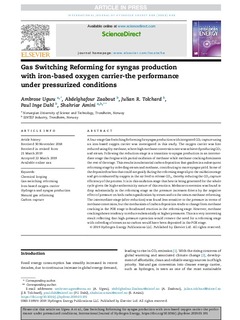| dc.contributor.author | Ugwu, Ambrose | |
| dc.contributor.author | Zaabout, Abdelghafour | |
| dc.contributor.author | Tolchard, Julian R | |
| dc.contributor.author | Dahl, Paul Inge | |
| dc.contributor.author | Amini, Shahriar | |
| dc.date.accessioned | 2020-03-12T12:23:34Z | |
| dc.date.available | 2020-03-12T12:23:34Z | |
| dc.date.created | 2019-05-01T15:17:22Z | |
| dc.date.issued | 2019 | |
| dc.identifier.citation | International journal of hydrogen energy. 2019, 45 (2), 1267-1282. | nb_NO |
| dc.identifier.issn | 0360-3199 | |
| dc.identifier.uri | http://hdl.handle.net/11250/2646578 | |
| dc.description.abstract | A four-stage Gas Switching Reforming for syngas production with integrated CO2 capture using an iron-based oxygen carrier was investigated in this study. The oxygen carrier was first reduced using dry methane, where high methane conversion rate was achieved producing CO2 and steam. Following the reduction stage is a transition to syngas production in an intermediate stage that begins with partial oxidation of methane while methane cracking dominates the rest of the stage. This results in substantial carbon deposition that gasifies in a subsequent reforming stage by cofeeding steam and methane, contributing to more syngas yield. Some of the deposited carbon that could not gasify during the reforming stage slip to the oxidation stage and get combusted by oxygen in the air feed to release CO2, thereby reducing the CO2 capture efficiency of the process. It is in this oxidation stage that heat is being generated for the whole cycle given the high exothermicity nature of this reaction. Methane conversion was found to drop substantially in the reforming stage as the pressure increases driven by the negative effect of pressure on both carbon gasification by steam and on the steam methane reforming. The intermediate stage (after reduction) was found less sensitive to the pressure in terms of methane conversion, but the mechanism of carbon deposition tends to change from methane cracking in the POX stage to Boudouard reaction in the reforming stage. However, methane cracking shows a tendency to reduce substantially at higher pressures. This is could be a promising result indicating that high-pressure operation would remove the need for the reforming stage with steam as no carbon would have been deposited in the POX stage. | nb_NO |
| dc.language.iso | eng | nb_NO |
| dc.publisher | Elsevier | nb_NO |
| dc.rights | Navngivelse 4.0 Internasjonal | * |
| dc.rights.uri | http://creativecommons.org/licenses/by/4.0/deed.no | * |
| dc.title | Gas Switching Reforming for syngas production with iron-based oxygen carrier-the performance under pressurized conditions | nb_NO |
| dc.type | Journal article | nb_NO |
| dc.type | Peer reviewed | nb_NO |
| dc.description.version | acceptedVersion | nb_NO |
| dc.source.pagenumber | 1267-1282 | nb_NO |
| dc.source.volume | 45 | nb_NO |
| dc.source.journal | International journal of hydrogen energy | nb_NO |
| dc.source.issue | 2 | nb_NO |
| dc.identifier.doi | 10.1016/j.ijhydene.2019.03.191 | |
| dc.identifier.cristin | 1694935 | |
| dc.description.localcode | ©2019 The Authors. Published by Elsevier Ltd on behalf of Hydrogen Energy PublicationsLLC. This is an open access article under the CC BY license (http://creativecommons.org/licenses/by/4.0/). | nb_NO |
| cristin.unitcode | 194,64,25,0 | |
| cristin.unitname | Institutt for energi- og prosessteknikk | |
| cristin.ispublished | true | |
| cristin.fulltext | postprint | |
| cristin.qualitycode | 1 | |

